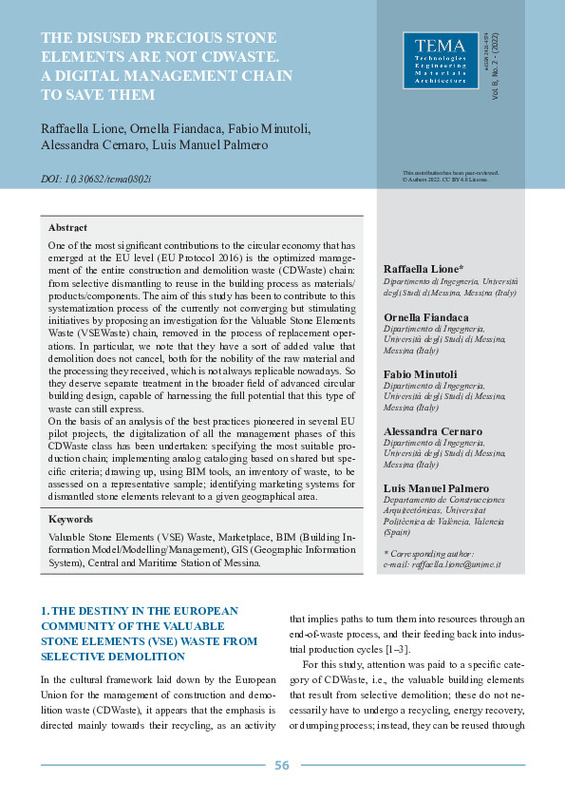JavaScript is disabled for your browser. Some features of this site may not work without it.
Buscar en RiuNet
Listar
Mi cuenta
Estadísticas
Ayuda RiuNet
Admin. UPV
The disused precious stone elements are not CDWaste. A digital management chain to save them
Mostrar el registro sencillo del ítem
Ficheros en el ítem
| dc.contributor.author | Lione, Raffaella
|
es_ES |
| dc.contributor.author | Fiandaca, Ornella
|
es_ES |
| dc.contributor.author | Minutoli, Fabio
|
es_ES |
| dc.contributor.author | Cernaro, Alessandra
|
es_ES |
| dc.contributor.author | Palmero Iglesias, Luís Manuel
|
es_ES |
| dc.date.accessioned | 2023-07-14T18:01:13Z | |
| dc.date.available | 2023-07-14T18:01:13Z | |
| dc.date.issued | 2022-12-20 | es_ES |
| dc.identifier.uri | http://hdl.handle.net/10251/194995 | |
| dc.description.abstract | [EN] One of the most significant contributions to the circular economy that has emerged at EU level (EU Protocol 2016) is the optimised management of the entire construction and demolition waste (CDWaste) chain: from selective dismantling to reuse in the building process as materials/products/components. The aim of this study has been to contribute to this systematization process of the currently not converging but stimulating initiatives by proposing an investigation for the Valuable Stone Elements Waste (VSEWaste) chain, removed in the process of replacement operations. In particular, we note that they have a sort of added value that demolition does not cancel, both for the nobility of the raw material and the processing they received, which is not always replicable nowadays. So they deserve separate treatment in the broader field of advanced circular building design, capable of harnessing the full potential that this type of waste can still express. On the basis of an analysis of the best practices pioneered in several EU pilot projects, the digitalisation of all the management phases of this CDWaste class has been undertaken: specifying the most suitable production chain; implementing analog cataloging based on shared but specific criteria; drawing up, using BIM tools, an inventory of waste, to be assessed on a representative sample; identifying marketing systems for dismantled stone elements relevant to a given geographical area. | es_ES |
| dc.language | Inglés | es_ES |
| dc.publisher | ArTec | es_ES |
| dc.relation.ispartof | TEMA | es_ES |
| dc.rights | Reconocimiento (by) | es_ES |
| dc.subject | Valuable Stone Elements (VSE) Waste | es_ES |
| dc.subject | Marketplace | es_ES |
| dc.subject | BIM (Building Information Model/Modelling/Management) | es_ES |
| dc.subject | GIS (Geographic Information System) | es_ES |
| dc.subject | Central and Maritime Station of Messina. | es_ES |
| dc.subject.classification | CONSTRUCCIONES ARQUITECTONICAS | es_ES |
| dc.title | The disused precious stone elements are not CDWaste. A digital management chain to save them | es_ES |
| dc.type | Artículo | es_ES |
| dc.identifier.doi | 10.30682/tema0802i | es_ES |
| dc.rights.accessRights | Abierto | es_ES |
| dc.contributor.affiliation | Universitat Politècnica de València. Escuela Técnica Superior de Gestión en la Edificación - Escola Tècnica Superior de Gestió en l'Edificació | es_ES |
| dc.description.bibliographicCitation | Lione, R.; Fiandaca, O.; Minutoli, F.; Cernaro, A.; Palmero Iglesias, LM. (2022). The disused precious stone elements are not CDWaste. A digital management chain to save them. TEMA. 8(2):56-75. https://doi.org/10.30682/tema0802i | es_ES |
| dc.description.accrualMethod | S | es_ES |
| dc.relation.publisherversion | https://doi.org/10.30682/tema0802i | es_ES |
| dc.description.upvformatpinicio | 56 | es_ES |
| dc.description.upvformatpfin | 75 | es_ES |
| dc.type.version | info:eu-repo/semantics/publishedVersion | es_ES |
| dc.description.volume | 8 | es_ES |
| dc.description.issue | 2 | es_ES |
| dc.identifier.eissn | 2421-4574 | es_ES |
| dc.relation.pasarela | S\482260 | es_ES |








